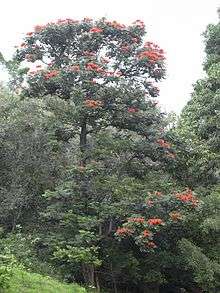Spathodea
| Spathodea | |
|---|---|
 | |
| Scientific classification | |
| Kingdom: | Plantae |
| (unranked): | Angiosperms |
| (unranked): | Eudicots |
| (unranked): | Asterids |
| Order: | Lamiales |
| Family: | Bignoniaceae |
| Tribe: | Tecomeae |
| Genus: | Spathodea |
| Species: | S. campanulata |
| Binomial name | |
| Spathodea campanulata P.Beauv. | |
Spathodea is a monotypic genus in the flowering plant family Bignoniaceae. The single species it contains, Spathodea campanulata, is commonly known as the African tuliptree,[1] fountain tree, pichkari or Nandi flame. The tree grows between 7–25 m (23–82 ft) tall and is native to tropical dry forests of Africa. It has been nominated as among 100 of the "World's Worst" invaders.
This tree is planted extensively as an ornamental tree throughout the tropics and is much appreciated for its very showy reddish-orange or crimson (rarely yellow), campanulate flowers. The generic name comes from the Ancient Greek words σπαθη (spathe) and οιδα (oida),[2] referring to the spathe-like calyx.[3] It was identified by Europeans in 1787 on the Gold Coast of Africa.[4]
Description
The flower bud is ampule-shaped and contains water. These buds are often used by children who play with its ability to squirt the water. The sap sometimes stains yellow on fingers and clothes. The open flowers are cup-shaped and hold rain and dew, making them attractive to many species of birds.
Species associations
In Neotropical gardens and parks, their nectar is popular with many hummingbirds, such as the black-throated mango (Anthracothorax nigricollis), the black jacobin (Florisuga fusca), or the gilded hummingbird (Hylocharis chrysura).[5] The wood of the tree is soft and is used for nesting by many hole-building birds such as barbets.
Geographic distribution
- Native to: Angola, Ethiopia, Ghana, Kenya, Sudan, Tanzania, Uganda, Zambia
- Exotic in: Australia, Colombia, Costa Rica, Cuba, Fiji, India, Jamaica, Papua New Guinea, Puerto Rico, Sri Lanka, Zanzibar, Hawaii, Philippines
It has become an invasive species in many tropical areas such as Hawaii, Queensland (Australia), Fiji, Papua New Guinea, and the wet and intermediate zones of Sri Lanka.[6]
S. campanulata is a declared class 3 pest species in Queensland, Australia, under the Land Protection (Pest and Stock Route Management) Act 2002.[7]
Pests and diseases
In Uganda, two lepidopteran species, two termite species, and one bark beetle attack S. campanulata. In Puerto Rico nine insect species in the orders Hemiptera, Hymenoptera, Lepidoptera, and Thysanoptera have been reported as feeding on various parts of S. campanulata. The species is quite susceptible to butt and heart rot; wood of the tree rots quickly when in contact with the ground.
Common names
- Afrikaans: fakkelboom, Afrika-vlamboom
- Kannada: Neerukayi mara (ನೀರುಕಾಯಿ ಮರ)
- English: African tulip tree, fountain tree, Nandi flame, Nile flame, squirt tree, tulip tree, Uganda flame
- French: immortel étranger
- Hindi: rugtoora (रुग्तूरा)
- Malayalam: Poomaram (പൂമരം)
- Luganda: kifabakazi
- Luhya: muzurio
- Malay: panchut-panchut
- Sinhala: kudaella gaha, kudulu, Hujja
- Spanish: amapola, espatodea, mampolo, tulipán africano, in Puerto Rico meaíto.
- Swahili: kibobakasi, kifabakazi
- Tamil: patadi (பாசடி)
- Trade name: Nandi flame
Gallery
_flower_in_Narshapur%2C_AP_W_IMG_0721.jpg)
flower _at_Secunderabad_W_IMG_6626.jpg)
fruit 
bark 
habitus 
buds 
seed yellow cultivar
Footnotes
- ↑ "Spathodea campanulata". Natural Resources Conservation Service PLANTS Database. USDA. Retrieved 24 November 2015.
- ↑ Gledhill, D. (2008). The Names of Plants (4 ed.). Cambridge University Press. p. 357. ISBN 978-0-521-86645-3.
- ↑ Quattrocchi, Umberto (2000). CRC World Dictionary of Plant Names. 4 R-Z. Taylor & Francis US. p. 2526. ISBN 978-0-8493-2678-3.
- ↑ African Tulip Tropical Tree
- ↑ Baza Mendonça & dos Anjos (2005)
- ↑ Invasive Species Compendium and Lalith Gunasekera, Invasive Plants: A guide to the identification of the most invasive plants of Sri Lanka, Colombo 2009, pp. 70–71.
- ↑ Land Protection (Pest and Stock Route) Regulation 2003 (Qld) - Schedule 2
References
- Baza Mendonça, Luciana & dos Anjos, Luiz (2005): Beija-flores (Aves, Trochilidae) e seus recursos florais em uma área urbana do Sul do Brasil [Hummingbirds (Aves, Trochilidae) and their flowers in an urban area of southern Brazil]. [Portuguese with English abstract] Revista Brasileira de Zoologia 22(1): 51–59. doi:10.1590/S0101-81752005000100007 PDF fulltext
- http://www.issg.org/database/species/ecology.asp?si=75
External links
-
 Data related to Spathodea campanulata at Wikispecies
Data related to Spathodea campanulata at Wikispecies -
 Media related to Spathodea at Wikimedia Commons
Media related to Spathodea at Wikimedia Commons